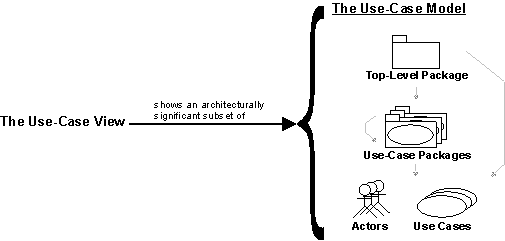Concepts:
Use-Case View
To provide a basis for planning the technical contents of iterations, an architectural
view called the use-case view is used in the Requirements
discipline. There is only one use-case view of the system, which illustrates the
use cases and scenarios that encompass architecturally significant behavior,
classes, or technical risks. The use-case view is refined and considered
initially in each iteration.

The use-case view shows an architecturally significant
subset of the use-case model, a subset of the use cases and actors.
The analysis, design, and implementation activities subsequent to
requirements are centered on the notion of an architecture.
The production and validation of that architecture is the main focus of the
early iterations, especially during the Elaboration
phase. Architecture is represented by a number of different architectural
views, which in their essence are extracts illustrating the
"architecturally significant" elements of the models.
There are four additional views: the Logical
View, Process View,
Deployment View, and Implementation
View. These views are handled in the Analysis
& Design and Implementation disciplines.
The architectural views are documented in a Software
Architecture Document. You may add different views, such as a
security view, to convey other specific aspects of the software architecture.
So, in essence, architectural views can be seen as abstractions or
simplifications of the models built, in which you make important characteristics
more visible by leaving the details aside. The architecture is an important
means for increasing the quality of any model built during system development.
Copyright
© 1987 - 2001 Rational Software Corporation
|  Disciplines >
Disciplines >
 Requirements >
Requirements >
 Concepts >
Concepts >
 Use-Case View
Use-Case View
 Disciplines >
Disciplines >
 Requirements >
Requirements >
 Concepts >
Concepts >
 Use-Case View
Use-Case View